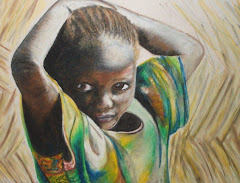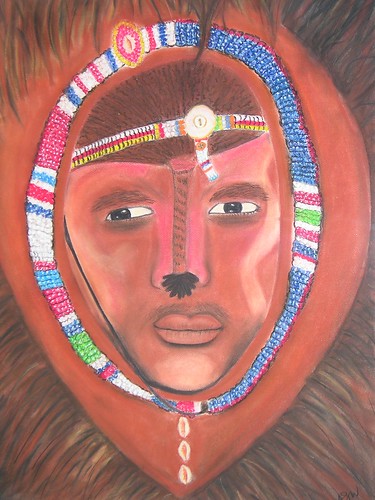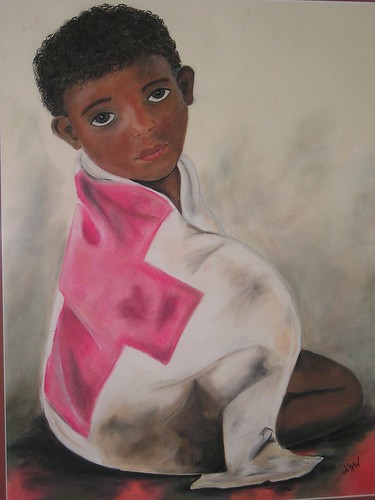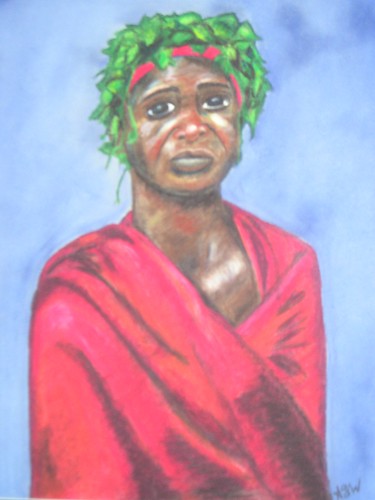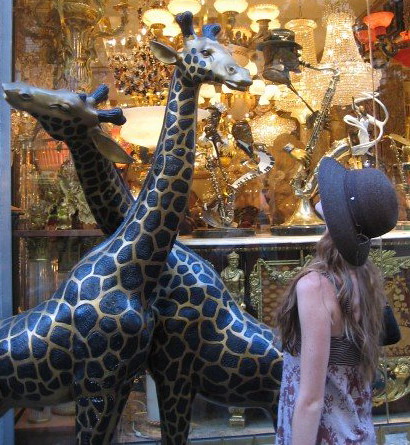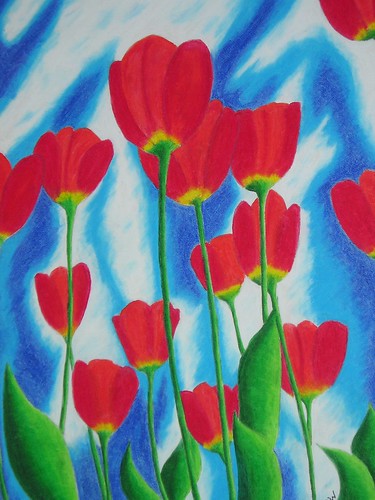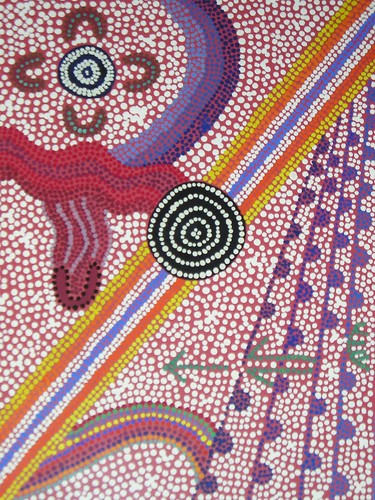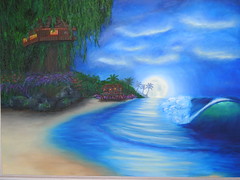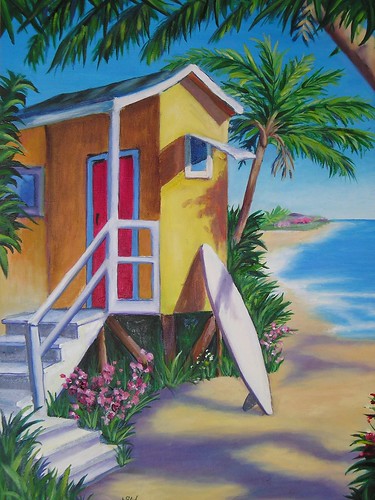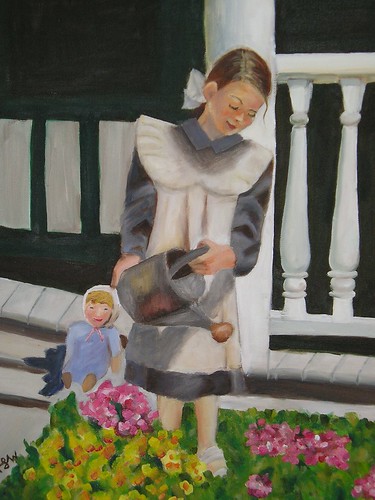Saturday, July 10, 2010
The Question
It's an impossible question with many different answers, but I will do my best to give you the simplest one...
First, a bit of background: While diarrheal disease is uncommon and easily treatable in the "developed" world, it is a common cause of death in developing countries. Diarrhea due to infection can last a few days or sometimes several weeks, Diarrhea is actually a symptom of an infection caused by bacterial, viral, or parasitic organisms (many of which are found in contaminated drinking water). Diarrhea disease is common in areas where there is a shortage of clean drinking water.
Diarrhea causes rapid depletion of both water and sodium. if the water and salts are not replaced quickly, the body becomes dehydrated. Severe diarrhea is often life threatening to infants an young children due to the amount of fluid lost. The World health Organization estimates that dehydration caused by diarrheal disease is responsible for 1.8 million deaths per year; 90% of these deaths occur among children under 5, mostly in developing countries (2004).
The research I am working on here focuses on the link between health outcomes and water quality. Many slum communities do not have access to running water most of the day. Instead, there is about a period of 4 hours when families must collect enough water to use throughout the day. Water must be collected for everything: showering, cooking, drinking, laundry, and cleaning. because water can only be collected during a set time, it must be stored all day. Past studies have shown that water coming from the tap is relatively clean and safe to drink. However, stored water is often very contaminated.
For this reason, many educational interventions focus on promoting water treatment options (boiling, filtration, chlorine, etc) and safe water storage methods (covering water, distinguishing between drinking water and water used for other things, etc). Additionally, treatment options are often expensive, time consuming, and potentially unnecessary.
This summer, our team is trying to determine at what point throughout the day water contamination occurs. We want to understand what happens to the water from the time it comes out of the tap to the time it is consumed. Once we ave a more nuanced understanding of how water is used, we may be able to design a more appropriate intervention for this particular community.
To do this, we are conducting a number of in home observations and testing the quality of the water. What does this mean? Usually it means we go into the community around 6am when the family collects water so that we can test it right when it comes out of the tap. We then spend 4 to 5 hours inside the home just observing. We watch how water is handled, what it is used for, and how it is stored. We also take a number of additional water samples throughout the day so that we can try to determine what is causing contamination and when.
Sound like an impossible challenge? It definitely feels that way at times! but, we have already learned so much and many of our previously accepted assumptions are being flipped upside down. needless to say, we are all really excited about the result and what they will mean for future health interventions.
Well, that was a snapshot of my project! And one answer to the impossible question.
Love from Mumbai
Tuesday, June 22, 2010
Behrampada
I’ve been working primarily in a slum in Bandra called Behrampada (“Behram” for short). It’s on 7 acres of land just east of the train station. There are approximately 10,000 shanties/ structures with a low estimate of 70,000 residents. As soon as you walk into Behram, the air changes. It smells like rotting meat and sewage. Most houses are about 10ft by 12ft. and are 4 to 5 stories high. There are usually a couple families living in each shanty building. The shanties are separated by small lanes about 3 feet across. So if someone is walking towards you, you have to stand flat against one of the houses to let them pass. Because the shanties are built up so high, there is very little sunlight, making the lanes dark and damp. The structures are built unevenly and electrical lines hang down from them so you often have to duck when walking through the lanes. All of the sewage is open – there are a series of gutters running down the lanes, in between the houses. It’s so dirty that it blends in with the wet ground/ mud. The other day, as I was walking down a particularly dark lane just after it had rained, I stepped right into one! So so soooo disgusting! I walked around with human shit on my foot all day long!
In order to get to a family at the second floor of a structure, you have to climb up a steep ladder and through a hole in the ceiling of the first floor. To get to the fourth floor you have to climb up three separate stepladders and often crawl up holes in the roofs of four other families. Behram is a pretty intimidating place to walk into as an outsider, but the more we are there, the more people seem to recognize us. For the most part, people are kind and very very curious. Once again I am learning that smiles are a universal language.
After a particularly long day of recruiting families to participate in our research study, we walked past a big plot of dirt/ field where about 30 to 40 kids were playing a game of cricket. Lost in our thoughts and conversations we walked right onto the field and into their game. They stopped playing and gathered around us with understandable curiosity. I’ve wondered about cricket since my first trip to India. The men in the Tata Chemicals compound would play at night sometimes. I always wanted to try it, but there were never any other women playing. Without thinking I asked one of the boys if I could try hitting the ball. He quickly handed me the bat and eagerly waited for me to get into position.
I was really nervous I was going to completely whiff it!! The boy that was pitching got close and threw the ball to me really softly - kind of like a father would pitch a baseball to a son who was just learning to bat. Expecting to miss, I totally hit the ball!! All of the boys were jumping up and down. I was jumping up and down. Everyone was cheering. They were all giving me high fives and wanting me to try again. Some of the families in the slum houses around the field looked out their windows. I even caught a couple people smiling at the ridiculous tall white girl playing cricket with the little boys. It almost made up for walking around with shit on my foot the day before… almost. Smile
Monday, June 7, 2010
Here we go again! India: Round 3
I hope to do a better job this summer of documenting my experiences. It's difficult to describe what goes on in the city that never sleeps. It's even more difficult to paint an accurate depiction of the people I meet and the slum areas where I work. But I will do my best. Please remember however, that the images i describe and the insights i may offer are but one view of a complex, multidimensional, and ever changing society. My experiences are just a single story of a nation with a library of tales to share.
With that said, I am very excited to see what kind of mischief I will get myself into this time around.
As anxious as I am about arriving in Mumbai late tonight, I have no doubt that with a slight wiggle of the head, India will again welcome me with open arms. And with my first cup of piping hot chai, I will feel right back at home.
Love from Amsterdam
Tuesday, July 14, 2009
So.. what exactly is a slum anyway?
For the past 6 weeks i have been working with HMS, a UC Berkeley student run organization, that works on health and sanitation in the slum communities of Mumbai. While i have been in slums in other developing countries, I have never really known how to define a slum. A lot of my time here is spent reflecting on my surroundings and the realities of poverty, foreign aid, and everyday life in Mumbai "slums".
So, i will finally begin trying to relay my experience by trying to answer the question i am asked most often: "So what exactly is a slum anyway?"...
The United Nations agency, UN-Habitat, defines a "slum" as a run-down area of a city characterized by substandard housing and squalor and lacking in tenure security. In the past, the term "slum" has been used to refer to housing areas that were once respectable but have sinse deteriorated as their original dwellers move on to newer and better parts of the city. Today we use the term slum to also include informal settlements found in cities in the developing world.
According to the UN, one billion people worldwide live in slums and the number is expected to grow to 2 billion by 2030. The Indian government has announced that the number of people living in slums in India now exceeds the entire population of Britain!
As expected, people living in slum communities are generally very poor and often socially disadvantaged. Depending on the individual slum, the buildings vary from simple shacks/ shanties to permanent well-maintained structures. In densely populated areas like Mumbai, many slums growing vertically to include three or four story buildings, housing many families. Most slums lack clean water, electricity, sanitation and other basic services.
This summer, we have seen that slum politics are both intricate and complicated. Characterizing a housing areas as a "slum" often has harsh consequences for its inhabitants. Recently the UN-Habitat and the World Bank have been criticized for their 'Cities without Slums' campaign because it has led directly to a massive increase in forced evictions. In fact, many people have said that the recent fire in Behrampada, a slum that HMS has worked in since 2004, was started intentionally. one man i met from the British consulate told me "Well you know as well as i do that is valuable land". The deep, complex social structure of slums is also complicated and often difficult for outsiders to understand.
Currently, the education team is working mainly in the Dharavi slum, which is often cited as "the largest slum in Asia" with over 1 million residents. It has also become more well known because parts of Slumdog millionaire were filmed in Dharavi. Dharavi provides a cheap, but illegal, housing where rents in 2006, were as low as 4 US dollars per month. Until this trip i have not thought too much about slum economics, but i have learned that Dharavi exports a number of goods around the world.
The population of Dharavi is predominantly Muslim, including migrants from Gujarat who have established a potters' colony and tanners from Tamil Nadu who have set up a large leather tanning industry. Other artisans from Uttar Pradesh region (where i spent time last summer) started the ready-made garments trade. The total turnover is estimated to be between 500 million US dollars and over 650 million US dollars per year!!
This summer, we are piloting a handwashing education program in Dharavi schools which we hope will ultimately become self sustaining. I hope to write more about the program and my experiences soon. It's definitely been a roller coaster of a ride with high highs and low lows, but i am trying to appreciate every second of it. Thank you for your messages and emails - it is always great to hear from home.
BBC - Dhaaravi "Life in a Slum"
Love from India
Tuesday, June 16, 2009
Genocide. Have we learned?
I’m stuck in the UK... I left India for a couple of days to attend Oma’s funeral service in Amsterdam. On the return flight, weather, bad luck, and maybe a little bit of fate aligned to keep me in London for the night. So I’ve had a lot of time to catch up on thinking and reading.
In preparation fro visiting me in Cambodia, my mom is reading First They Killed My Father by Loung Ung. It is about her family’s experience during the time of the Khmer Rouge and the Cambodian Genocide. The story is haunting. Almost overnight middle class families were forced to flee their homes and taken to the countryside. Universities, hospitals and banks were burned. Political and civil rights were abolished. Religion and music were banned. Even clocks and watches were destroyed. Any symbol of modernity, any un-communist aspect of traditional Cambodian society was to be eliminated. Teachers, doctors, lawyers, scientists, musicians, philosophers, and politicians were killed along with their extended families.
Minority groups, especially the ethnic Chinese were targeted. One Khmer slogan ran 'To spare you is no profit, to destroy you is no loss.' It’s hard to believe that this could happen in the matter of days, and even harder still to know that it happened only 35 years ago during the lifetime of my parents.
How did it happen? That part is possibly the most difficult to comprehend.
In 1962, Pol Pot, leader of the Cambodian Communist Party formed an armed resistance movement that became known as the Khmer Rouge and waged a guerrilla war against Prince Sihanouk’s government.
In 1970, Prince Sihanouk however, was ousted due to a US backed right wing military coup. Sihanouk retaliated by joining Pol Pot (his former enemy) in opposing the new military government. That same year, the US invaded Cambodia to expel the North Vietnamese from their border encampments, but ended up driving them deeper into Cambodia allowing them to ally themselves with the Khmer Rouge.
From 1969 until 1973, the U.S. intermittently bombed North Vietnamese sanctuaries in eastern Cambodia An estimated 150,000 Cambodian peasants were killed. As a result, peasants fled the countryside by the hundreds of thousands and settled in Cambodia's capital city, Phnom Penh. All of these events resulted in economic and military destabilization in Cambodia and a surge of popular support for Pol Pot.
By 1975, the U.S. had withdrawn its troops from Vietnam. Cambodia's government, plagued by corruption and incompetence, also lost its American military support. Taking advantage of the opportunity, Pol Pot's Khmer Rouge army, consisting of teenage peasant guerrillas, marched into Phnom Penh and on April 17 effectively seized control of Cambodia.
Leaders of the Khmer Rouge are only now facing trial.
I’d like to think we learn something from history. From the genocides that have taken place across the globe. From the lives of Jews, Tutsis, Muslims, and Hindus lost.
But killing continues and human rights violations are abundant.
I read about the protests in Iran and the UK and think maybe we have learned something. There are plenty of people fighting against violence, repression, hatred, and injustice...
Then again, I can't help but wonder, will it be enough?
Back in Bombay tomorrow. Project update soon. Love from London
Tuesday, June 9, 2009
Train tickets and Tumeric
I found Liza and Ana outside of the airport and we took a cab back to the apartment. It is in the Andheri district of Mumbai. It’s a really nice place – simple and clean. We have three bedrooms, three bathrooms, a living room, and a kitchen with a dining table. The landlord installed a water filter and a refrigerator earlier this week. There is even air conditioning and sporadic wireless internet in one of the bedrooms.
Yesterday morning Justin and I took the train to meet Sadaf (another HMS team member), in Mumbai Central. The line for train tickets was 2 hours long and we only had 20 minutes to get to Mumbai central if we were going to make it on time. We could either be late for our meeting or ride without a ticket and risk getting a 400rs fine (8 US$). A normal ride is about 5Rs. Justin already had a pass, so we decided that splitting the fine would be worth getting to Sadaf on time. My only request was that we ride together in first class so that if I got caught with a man yelling at me in Hindi for a train ticket, I wouldn’t be alone. Well, as soon as the train pulled into the station that plan flew out the window.
A stampede of men grabbed onto the already overcrowded first class car. Justin managed to get a hand inside the door and onto a pole to hang on to. There was no way I was going to try to squeeze myself into a car full of men. So at the last second I ditched justin and ran to the women’s car (always directly behind the first class car). It too was completely packed, but I was able to get one foot on board as the train pulled away from the station. Some of the other women pulled me all the way inside the car. I managed to get off on the correct stop and found Justin on the platform. I smiled “I didn’t get ticketed”. Just as I spoke a man in a white collared uniform shirt tapped Justin on the arm. Instinct told me to keep walking. I didn’t look back until I was a good fifty feet away. Justin had pulled out his pass and was showing it to the official. When he finally caught up with me we gave one another a look of relief and laughed all the way out of the station.
After meeting with one of Bombay’s Municipal schools for our project, Justin and Sadaf told me that they had found a woman close to where we live in Andheri that had agreed to give us cooking lessons. So from 3 to 6pm I was in a stranger’s kitchen learning to make things like Aloo Palak, Jeera rice, and three different kinds of Daal. It was so much fun. We ended up making a total of 8 different dishes. Watching Nalini cook was like watching a magician. She would throw ingredients into a pan – cumin seeds, red chili powder, onions, tomatoes, a hint of cinnamon and before we could say Tumeric (which seems to be in everything) she was handing us a spoon to taste her creation. Everything was phenomenal! We have our second class later this week.
Today we have a meeting with PSI (Population Services International) and will be running some errands around the city.
Love from Mumbai.
Friday, May 29, 2009
E waste. aka Agbogbloshie. aka "wo ho ye fe paa"
Sunday, December 14, 2009
It was the day before our flight back to the US and Miriam and I had one last adventure ahead of us. She had read about an E-waste scrap yard, aka dumpsite, in Accra and wanted to see if we could find it. We once again jumped in the back of a trotro, not really having any idea where we were headed, but as usual people we met on the way pointed us in the right direction. We went from one trotro station to the next, finally figuring out which one had cars that would drop us off near the waste site. We told people we were trying to get to Agbogbloshie – the name of the scrap yard (yeah, try saying that three times fast!). We were directed to a trotro in the far corner of the station. It was a trotro unlike any other I had ever been inside. The doors opened in the back of the van and there were no windows and no way to communicate with the driver. There were benches rigged to both sides of what felt like the back of a cargo container. The van was full except for one seat. We had no idea when the next car would come so we told the mate that we could make it work. He seemed slightly amused as he watched Miriam and I climb over the other passengers and squeeze ourselves into the tiny space left in the middle. Their faces changed from confusion to surprised approval as I sat down and motioned for Miriam to sit on my lap.
Once we were on the road, I finally had a chance to survey the other people in the car. There was a man in long pants and a tattered dress shirt, an older women with crocked teeth smiling at us, a baby strapped to the back of its mother – head bobbing up and down with the movement of the car and of course a number of beautiful women. There was one woman in particular that I literally couldn’t take my eyes from. She was breathtakingly beautiful. She wore a typical full length Ghanaian dress, tight around her hips and flared at the ankles. Her head was covered with a piece of matching cloth tied up and knotted around her hair. I remember thinking that she looked so calm and glamorous sitting in the back of that car. I imagined where she was going – it wasn’t Sunday so it couldn’t have been church. A party? Maybe a wedding. Ya, that’s it, a wedding. The trotro came to a stop and brought my daydreaming to a halt. One by one we filed out of the van, thankful for the fresh air. Now what? We had no idea where we were going and we weren’t exactly sure how to tell people we were looking for a waste site. We decided to wander. We walked only for a couple of seconds before we noticed trash piled alongside the road. I glanced across the street at what looked like a river of sewage lined with trash and metal parts. We had found it.
 We walked into the scrap yard – a mixture of dirt and broken computer parts under our feet. The smell of burning trash and plastic welcomed us. We were both in sandals. Maybe I should have worn shoes? A little boy running around with bare feet interrupted this thought. There were broken motherboards and CDs, discarded bicycle frames, refrigerators, broken cars, rusting piles of metal, and rejected ovens and computers. We walked past a group of young men behind a gated off section of the yard. The sound of hammering and work stopped as they saw us approach. A couple of the braver ones came running out to greet us. I wasn’t sure how we were going to be received – as foreigners? intruders? I should have known we would be treated like friends. We couldn’t communicate with words and as we held out our hands to greet the young men, they hesitated. One of the men showed us his palms – they were covered in filth from working with the scrapes and wires. My heart sank a little as I glanced at my own perfectly Purell-ed hands. He didn’t want to get them dirty with his own. Instead they smiled and waved as we continued further into the yard.
We walked into the scrap yard – a mixture of dirt and broken computer parts under our feet. The smell of burning trash and plastic welcomed us. We were both in sandals. Maybe I should have worn shoes? A little boy running around with bare feet interrupted this thought. There were broken motherboards and CDs, discarded bicycle frames, refrigerators, broken cars, rusting piles of metal, and rejected ovens and computers. We walked past a group of young men behind a gated off section of the yard. The sound of hammering and work stopped as they saw us approach. A couple of the braver ones came running out to greet us. I wasn’t sure how we were going to be received – as foreigners? intruders? I should have known we would be treated like friends. We couldn’t communicate with words and as we held out our hands to greet the young men, they hesitated. One of the men showed us his palms – they were covered in filth from working with the scrapes and wires. My heart sank a little as I glanced at my own perfectly Purell-ed hands. He didn’t want to get them dirty with his own. Instead they smiled and waved as we continued further into the yard. The river of sewage seemed to separate the site into two parts: the side on which the e-waste was dumped and kept, and the side on which the people live. On the side opposite of where we stood, shanties lined the ‘river’. People actually live here. Raised their families here. This was their backyard. We noticed a small makeshift ‘bridge’ (slats of wood) connecting one side to the other. As we got closer, another group of young boys motioned for us to follow them across. Needless to say we both hesitated, imagining ourselves falling in the smelly river of human and manmade waste. We carefully balanced on the first board. One of the boys looked back and said encouragingly “It’s okay. Go small small” translating into take it slow, one step at a time. We made it across the bridge and climbed up the edge of the embankment. We walked along the front of the shanties. Some images that stuck with me: a small boy defecating on a pile of burned trash, a group of women sitting around a table playing a board game, a little girl rummaging through a mound of waste – a red streamer around her neck.
The river of sewage seemed to separate the site into two parts: the side on which the e-waste was dumped and kept, and the side on which the people live. On the side opposite of where we stood, shanties lined the ‘river’. People actually live here. Raised their families here. This was their backyard. We noticed a small makeshift ‘bridge’ (slats of wood) connecting one side to the other. As we got closer, another group of young boys motioned for us to follow them across. Needless to say we both hesitated, imagining ourselves falling in the smelly river of human and manmade waste. We carefully balanced on the first board. One of the boys looked back and said encouragingly “It’s okay. Go small small” translating into take it slow, one step at a time. We made it across the bridge and climbed up the edge of the embankment. We walked along the front of the shanties. Some images that stuck with me: a small boy defecating on a pile of burned trash, a group of women sitting around a table playing a board game, a little girl rummaging through a mound of waste – a red streamer around her neck.We walked past a group of men and women sitting on a bench. To my amazement one of them was the beautiful woman from the trotro. I was shocked to see her in her stunning dress and jewelry sitting in the middle of the scrap yard. She motioned for us to come and join them. We sat down on the bench and spent the next couple of minutes trying to remember as much Twi as we possibly could. After we ran out of greetings I clumsily blurted out “Wo ho ye fe paa” – you are very beautiful. The women smiled and blushed. Her friends laughed but agreed. We waved goodbye and continued on. There was a large truck overflowing with men and flags – red, white, back, and green. The sound of a bullhorn told us it was part of an NDC rally (the presidential election was still going on at this time).
I’m not sure what I had expected, but as we walked through this waste town I felt more and more confused. I couldn’t see the toxic chemicals, the chlorinated dioxins, or the phthalates that were slowly poisoning these people. All I could see was life. People doing the best they can with what they have. People welcoming strangers into their home. I don’t know when in my mind these people whom I had heard about, burning electronic cables, started being casualties instead of people. While Miriam and I walked out of the scrap yard I made a promise to myself: No matter how awful or unfair someone’s situation, no matter how hard people fight and fail to change it, never again will I assume that a person is a casualty, a victim, or a martyr. Never again will I assume that a person is anything less or different than a human being living his life the best way he knows how.
I am reminded of my Cameroonian friends Flynn and Brian and how they didn’t know me, but they took care of me. “You are my sister and I am your brother” was the only possible explanation I received or needed. Reflecting on this almost two years ago, I wrote, “We are family because we are human beings - we share a world, a history, and a vision.” Today I am a little more pragmatic and maybe a little less naïve. I have such mixed feelings on what actions foreigners, especially westerners, should take in order to “Save Africa” (See previous post). However, I do hope that someday we can stand up to the electronic companies in developed countries that are poisoning Ghanaians in Agbogbloshie, not because they are helpless victims, but because they are people, which make them family.
For more information:
Download full Greenpeace document here
Ghana's growing e-waste trade, BBC
UK's e-waste continues to be dumped in Ghana, Nigeria despite public outcry, Ghana Business news
More videos

